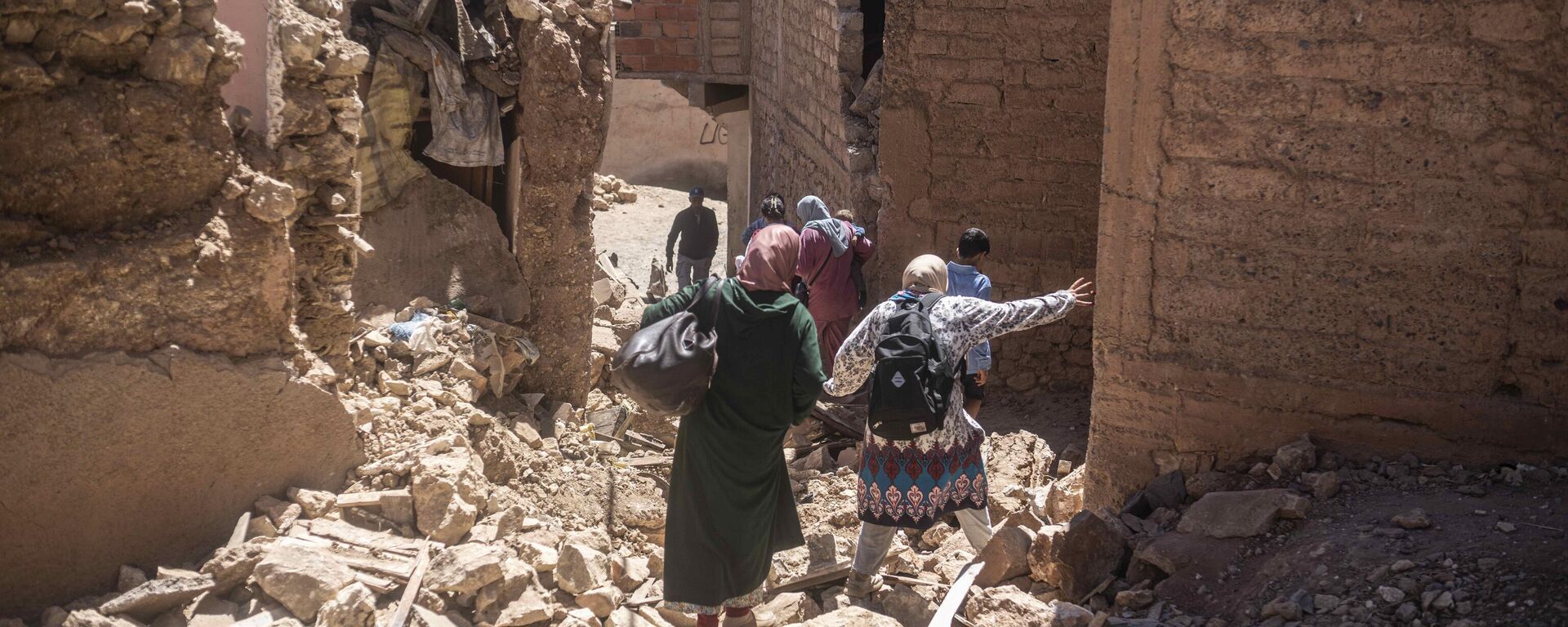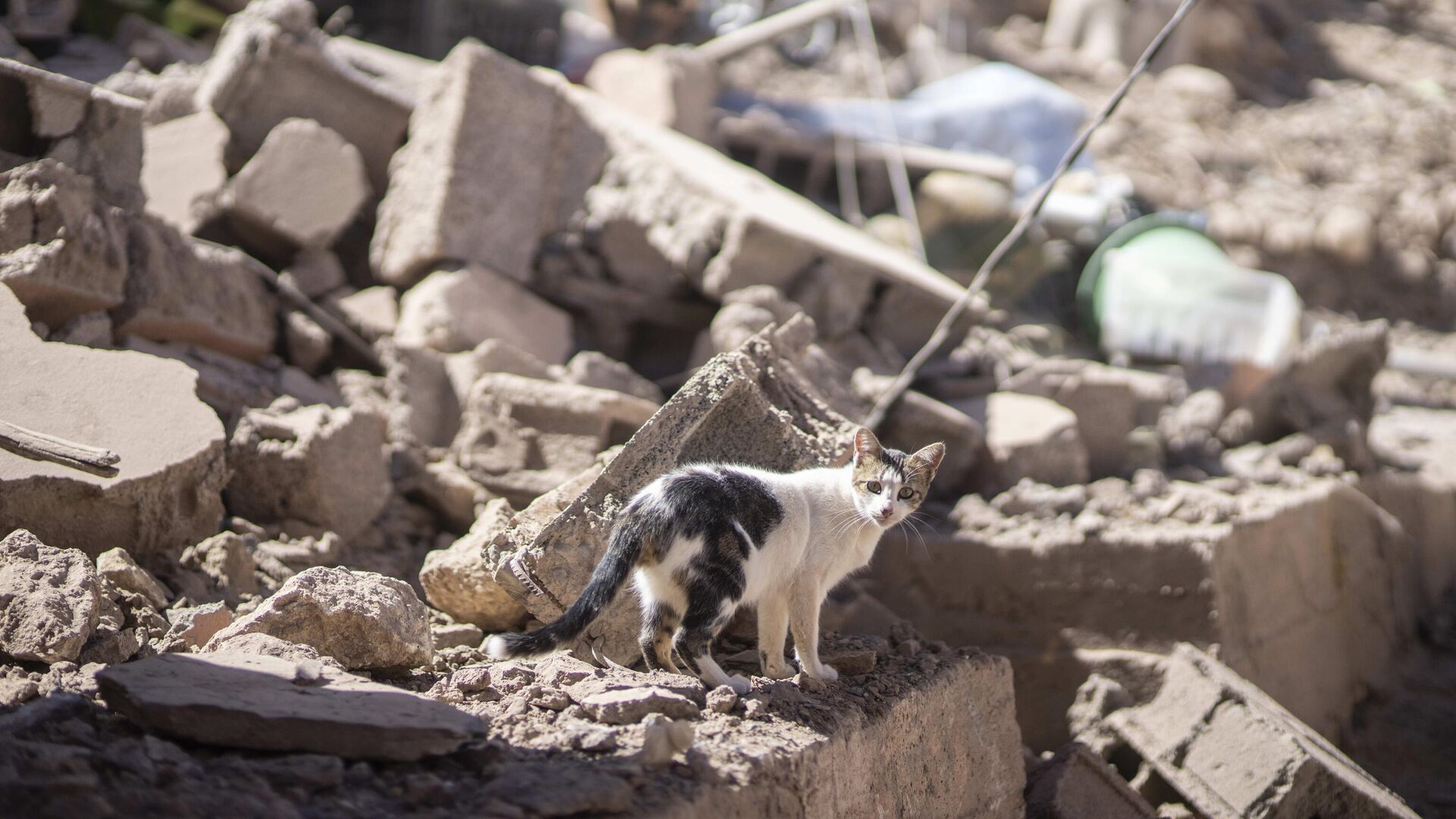https://sputnikglobe.com/20230909/moroccan-earthquake-equivalent-to-force-of-25-nuclear-bombs---seismologist-1113239883.html
Moroccan Earthquake Equivalent to Force of 25 Nuclear Bombs - Seismologist
Moroccan Earthquake Equivalent to Force of 25 Nuclear Bombs - Seismologist
Sputnik International
The power of the devastating earthquake that hit Morocco was equivalent to that of 25 nuclear bombs in terms of the amount of material contained in such bombs, Dr. Iyd al-Tarazi, a professor at the Department of Seismology and Natural Hazards at the Hashemite University in Jordan, told Sputnik Arabic.
2023-09-09T15:02+0000
2023-09-09T15:02+0000
2023-09-09T19:25+0000
morocco
africa
earthquake
https://cdn1.img.sputnikglobe.com/img/07e7/09/09/1113240632_0:320:3072:2048_1920x0_80_0_0_005aa5cf8bf3fd39980cdfba0d73c717.jpg
The power of the devastating earthquake that hit Morocco was equivalent to that of 25 nuclear bombs in terms of the amount of material contained in such bombs, Dr. Iyd al-Tarazi, a professor at the Department of Seismology and Natural Hazards at the Hashemite University in Jordan, told Sputnik Arabic.Regarding the impact of the Moroccan earthquake on neighboring countries, Al-Tarazi ruled out that it would have any strong stimulating effect on the Earth's crust in the surrounding region, especially in North Africa or the Middle East. So, in his opinion, the potential occurrence of similar destructive earthquakes in neighboring countries is unlikely.Regarding the possibility of predicting such earthquakes before they happen, Al-Tarazi explained that “they are usually unpredictable, since there are many reasons why scientists cannot know exactly when an earthquake will occur, but sometimes - and such cases are few - earthquakes may be preceded by increased activity in the Earth's crust, and before the main earthquake there is a series of small earthquakes of small magnitude, about 3 or 4 points. There may also be some changes in the magnetic field at the epicenter of the earthquake, the electric field and other layers of the earth, but these are not constant, so scientists cannot rely on them to try to predict such earthquakes.”The seismologist explained that the Moroccan earthquake will change many theories used by seismologists and geologists, since the region is located hundreds of kilometers from the boundary of the collision of lithospheric plates, but an earthquake of unexpected strength still occurred. “This will change some of the scientific concepts related to seismic sources, seismic zone boundaries and seismic activity.”
https://sputnikglobe.com/20230909/morocco-earthquake-survivors-people-live-on-streets-fearing-aftershocks-1113239391.html
morocco
africa
Sputnik International
feedback@sputniknews.com
+74956456601
MIA „Rossiya Segodnya“
2023
Sputnik International
feedback@sputniknews.com
+74956456601
MIA „Rossiya Segodnya“
News
en_EN
Sputnik International
feedback@sputniknews.com
+74956456601
MIA „Rossiya Segodnya“
Sputnik International
feedback@sputniknews.com
+74956456601
MIA „Rossiya Segodnya“
morocco, earthquake, earthquake in morocco, moroccan earthquake
morocco, earthquake, earthquake in morocco, moroccan earthquake
Moroccan Earthquake Equivalent to Force of 25 Nuclear Bombs - Seismologist
15:02 GMT 09.09.2023 (Updated: 19:25 GMT 09.09.2023) Late on Friday, a 6.9-magnitude earthquake hit Morocco 77 kilometers (48 miles) southwest of the city of Marrakesh. The latest reports indicate that the death toll from the disaster has reached 1,300 people, while 1,800 others have been injured. As many as 720 people among those injured are in critical condition, media reported.
The power of the
devastating earthquake that hit Morocco was equivalent to that of 25 nuclear bombs in terms of the amount of material contained in such bombs,
Dr. Iyd al-Tarazi, a professor at the Department of Seismology and Natural Hazards at the Hashemite University in Jordan, told
Sputnik Arabic.
“An earthquake with a magnitude of 7 on the Richter scale is very strong and can cause ground acceleration at the epicenter of the earthquake ranging from 200 to 300 cm per second, which can destroy objects, especially those not specifically designed to be resistant to earthquakes, when the foundations are not adequately prepared from the geological and topographical points of view."
Regarding the impact of the Moroccan earthquake on neighboring countries, Al-Tarazi ruled out that it would have any strong stimulating effect on the Earth's crust in the surrounding region, especially in North Africa or the Middle East. So, in his opinion, the potential occurrence of similar destructive earthquakes in neighboring countries is unlikely.

9 September 2023, 18:16 GMT
Regarding the possibility of predicting such earthquakes before they happen, Al-Tarazi explained that “they are usually unpredictable, since there are many reasons why scientists cannot know exactly when an earthquake will occur, but sometimes - and such cases are few - earthquakes may be preceded by increased activity in the Earth's crust, and before the main earthquake there is a series of small earthquakes of small magnitude, about 3 or 4 points. There may also be some changes in the magnetic field at the epicenter of the earthquake, the electric field and other layers of the earth, but these are not constant, so scientists cannot rely on them to try to predict such earthquakes.”
“Morocco is located far enough from the boundary of contact between the African and Eurasian tectonic plates, the distance to it is about 400 kilometers, so scientists previously ruled out the possibility of an earthquake of such magnitude in this region.”
The seismologist explained that the
Moroccan earthquake will change many theories used by seismologists and geologists, since the region is located hundreds of kilometers from the boundary of the collision of lithospheric plates, but an earthquake of unexpected strength still occurred. “This will change some of the scientific concepts related to seismic sources, seismic zone boundaries and seismic activity.”



